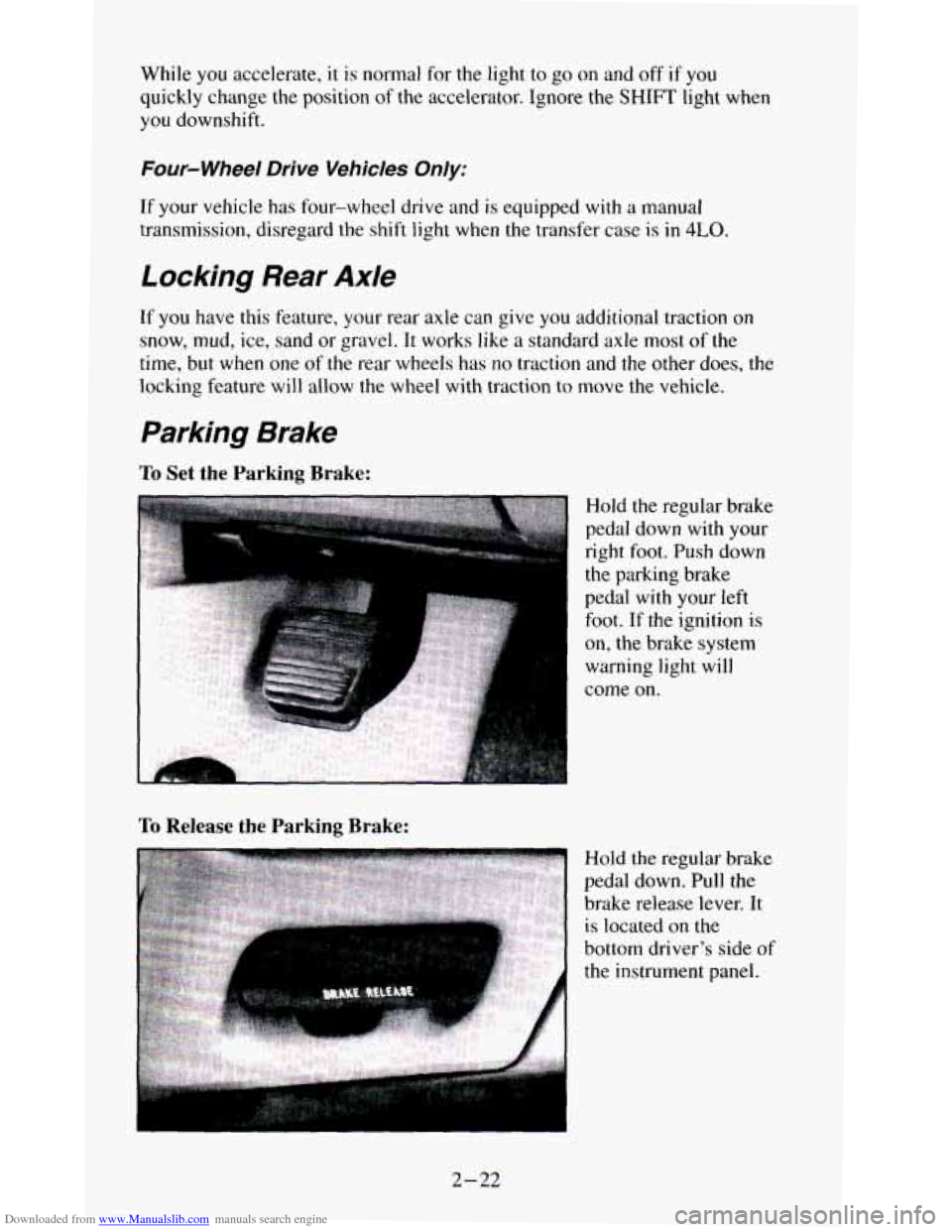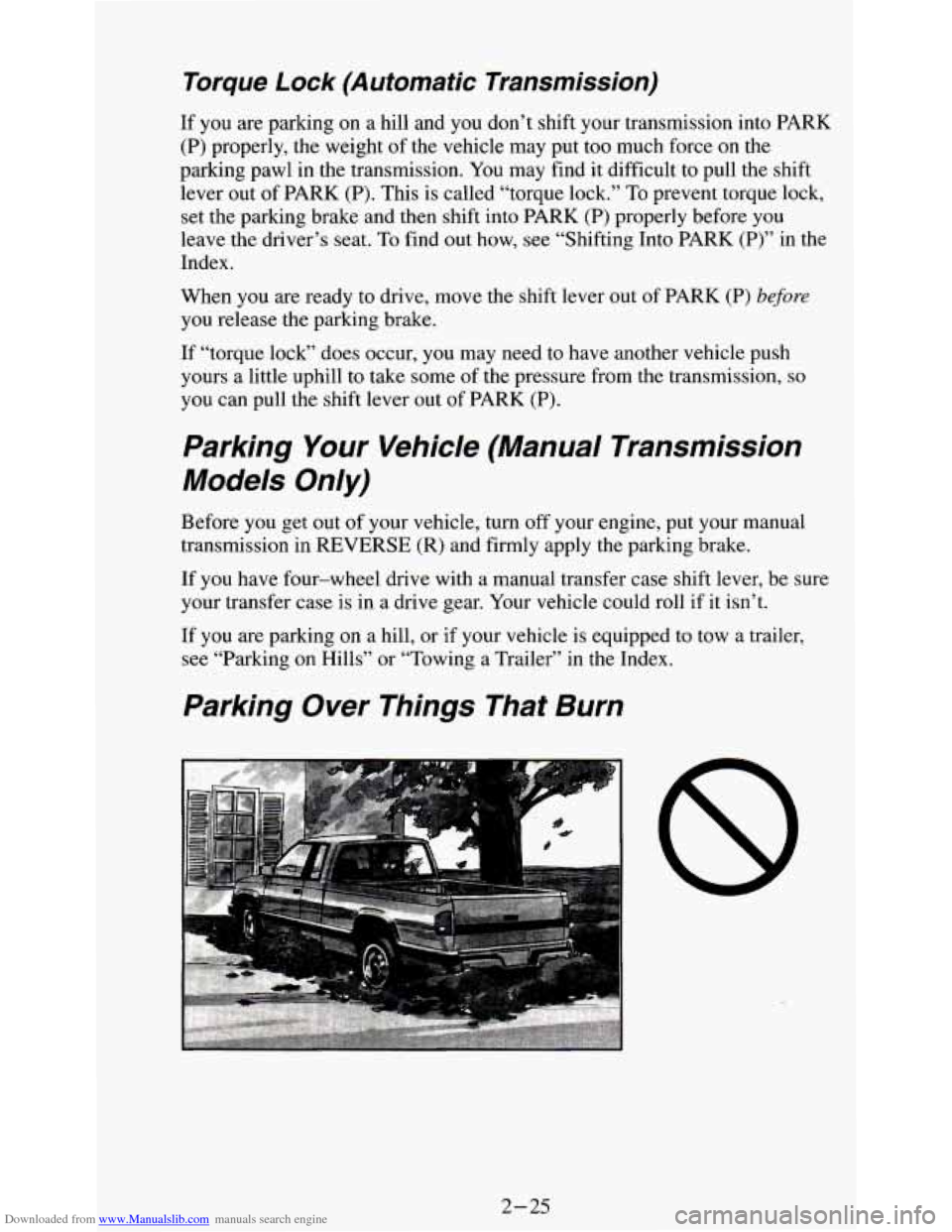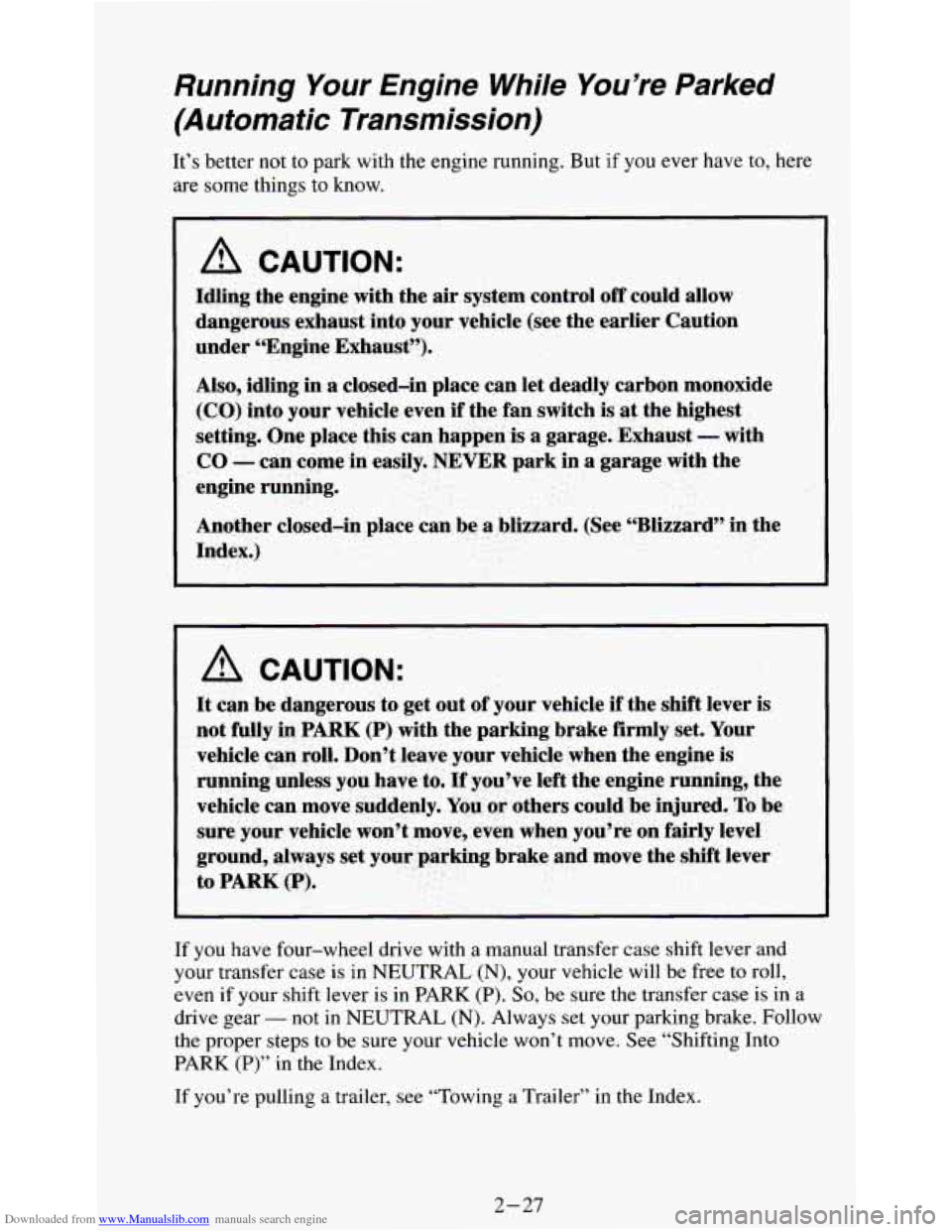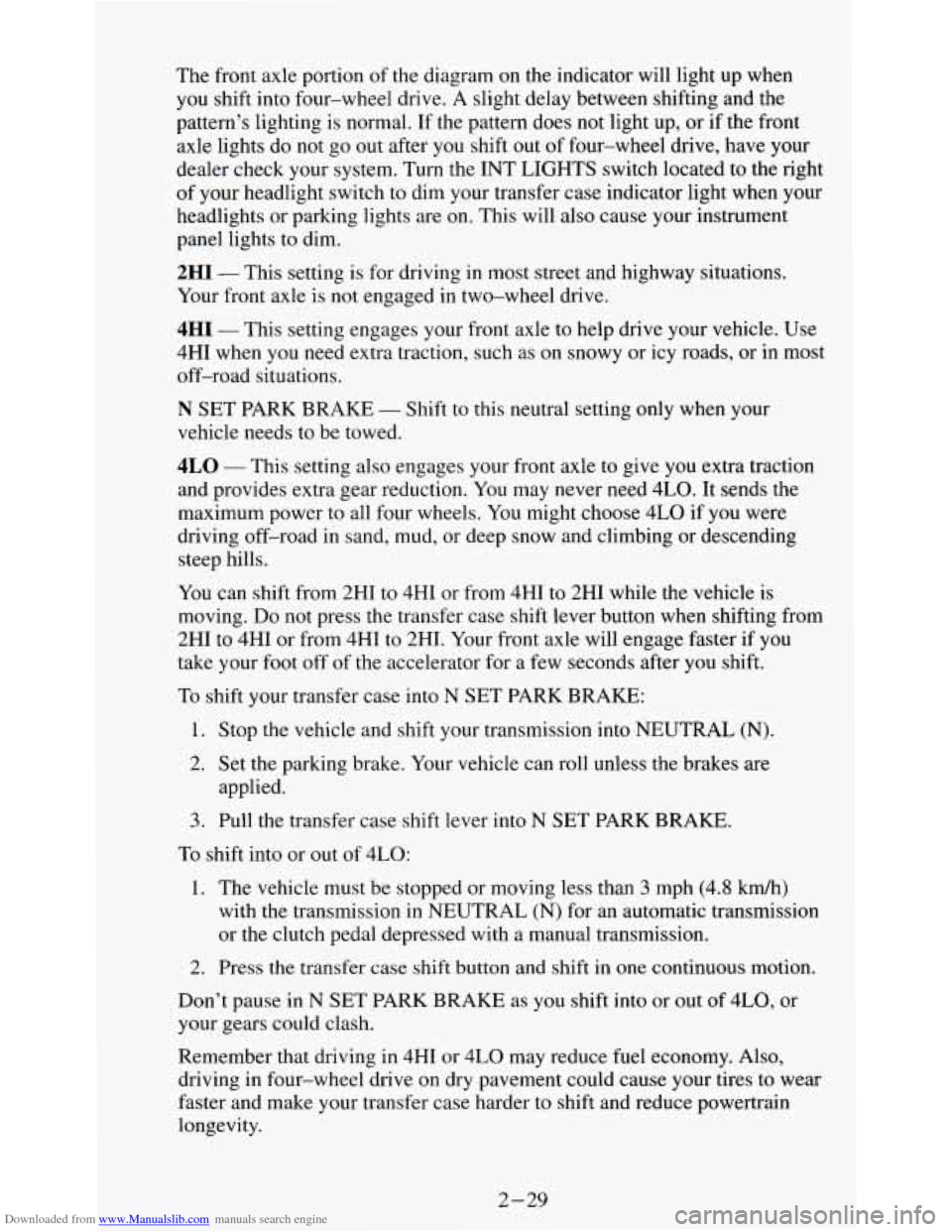1995 CHEVROLET S10 parking brake
[x] Cancel search: parking brakePage 54 of 354

Downloaded from www.Manualslib.com manuals search engine Parking at Nlght
Park in a lighted spot, close all windows and lock your vehicle. Remember
to keep your valuables out
of sight. Put them in a storage area, or take them
with you.
Parking Lots
If you park in a lot where someone will be watching your vehicle, it’s best
to lock
it up and take your keys. But what if you have to leave your ignition
key? What
if you have to leave something valuable in your vehicle?
Put your valuables in a storage area, like your glove box.
Lock all the doors except the driver’s.
New Vehicle “Break-In”
NOTICE:
Your modern vehicle doesn’t need an elaborate “break-in.” But
it will perform better in the long run if you follow these
guidelines:
0 Keep your speed at 55 mph (88 km/h) or less for the first 500
miles (804 km).
Don’t drive at any one speed - fast or slow - for the first
500 miles (804 km). Don’t make full-throttle starts.
Avoid making hard stops for the first 200 miles (322 km) or
so. During this time your new brake linings aren’t yet broken
in. Hard stops with new linings can mean premature wear and
earlier replacement. Follow this “breaking-in” guideline
every time you get new brake linings.
Don’t tow a trailer during “break-in.” See “Towing a Trailer”
in the Index for more information.
2-9
Page 63 of 354

Downloaded from www.Manualslib.com manuals search engine A CAUTION:
It is dangerous to get out of your vehicle if the shift lever is not
fully in
PARK (P) with the parking brake firmly set, Your
vehicle can roll.
Don’t leave your vehicle when the engine
is running unless you
have to.
If you have left the engine running, the vehicle can move
suddenly.
You or others could be injured. To be sure your vehicle
won’t move, even when you’re on
fairly level ground, always set
your parking brake and move the shift lever to
PARK (P),
If you have four-wheel drive, your vehicle will be free to roll -
even if your shift lever is in PARK (P) - if your transfer case is
in NEUTRAL (N). So, be sure the transfer case is in a drive gear,
two-wheel high (2HI) or four-wheel high (4HI) or four-wheel
low
(4LO) - not in NEUTRAL (N). See “Shifting Into PARK
(P)” in the Index. If you’re pulling a trailer, see “Towing a
Trailer” in the Index.
REVERSE (R) - Use this gear to back up.
NOTICE:
Shifting to REVERSE (R) while your vehicle is moving forward
could damage your transmission. Shift
to REVERSE (R) only
after your vehicle is stopped.
To rock your vehicle back and forth to get out of snow, ice or sand
without damaging your transmission,
see “If You’re Stuck: In Sand,
Mud, Ice or
Snow” in the Index.
0 NEUTRAL (N) - In this position, your engine doesn’t connect with
the wheels.
To restart when you’re already moving, use NEUTRAL (N)
only. Also, use NEUTRAL (N) when your vehicle is being towed.
2- 18
Page 66 of 354

Downloaded from www.Manualslib.com manuals search engine 0
0
0
0
0
FIRST GEAR ( 1 ), put the shift lever in NEUTRAL (N) and let up on the
clutch. Press the clutch pedal back down. Then shift into FIRST GEAR (1).
SECOND GEAR (2) - Press the clutch pedal as you let up on the
accelerator pedal and shift
into SECOND GEAR (2). Then, slowly let
up on the clutch pedal
as you press the accelerator pedal.
THIRD, FOURTH AND FIFTH GEARS (3,4 and 5) - Shift into
THIRD GEAR (3), FOURTH GEAR (4)- and FIFTH GEAR (5) the
same way you
do for SECOND GEAR (2). Slowly let up on the clutch
pedal as you press the accelerator pedal.
To Stop - Let up on the accelerator pedal and press the brake pedal.
Just before the vehicle stops, press the clutch pedal and the brake pedal,
and shift
to NEUTRAL (N).
NEUTRAL (N) - Use this position when you start or idle your engine.
REVERSE (R) - To back up, press down the clutch pedal, wait about
6 seconds. then shift into REVERSE (R). Then let up on the clutch
pedal slowly while pressing the accelerator pedal.
I NOTICE:
Shift to REVERSE (R) only after your vehicle is stopped.
Shifting
to REVERSE (R) while your vehicle is moving could
damage your transmission.
Also, use REVERSE (R), along with the parking brake, for parking
your vehicle.
SHIFT Light
If you have a manual
transmission, you
have an amber SHIFT
light. This light will
~
show you when to
shift to the next higher
gear for best fuel
economy. It
is located
at the top of your
cluster, above your
fuel gage.
When this light comes on,
you can shift to the next higher gear if weather,
road and traffic conditions let you.
For the best fuel economy, accelerate
slowly and
shift when the light comes on.
2-21
Page 67 of 354

Downloaded from www.Manualslib.com manuals search engine While you accelerate, it is normal for the light to go on and off if you
quickly change the position of the accelerator. Ignore the SHIFT light when
you downshift.
Four- Wheel Drive Vehicles Only:
If your vehicle has four-wheel drive and is equipped with a manual
transmission, disregard the shift light when the transfer case is in
4LO.
Locking Rear Axle
If you have this feature, your rear axle can give you additional traction on
snow, mud, ice, sand or gravel. It
works like a standard axle most of the
time, but when one
of the rear wheels has no traction and the other does, the
locking feature will allow the wheel with traction
to move the vehicle.
Parking Brake
To Set the Parking Brake:
To Release the Parking Brake:
Hold the regular brake
pedal down with your
right
foot. Push down
the parking brake
pedal
with your left
foot. If the ignition is
on, the brake system
warning light will
come on.
Hold the regular brake
pedal down. Pull the
brake release lever.
It
is located on the
bottom driver's side
of
the instrument panel.
2-22
Page 68 of 354

Downloaded from www.Manualslib.com manuals search engine NOTICE:
Driving with the parking brake on can cause your rear brakes to
overheat. You may have to replace them, and you could also
damage other parts
of your vehicle.
If you are on a hill: See “Parking on Hills” in the Index. That section
shows how to
turn your front wheels.
If you are towing a trailer and are parking on any hill: See “Towing a
Trailer” in the Index. That section shows what to do first to keep the trailer
from moving.
Shifting Into PARK (P)
(Automatic Transmission Models Only)
1. Hold the brake pedal down with your right foot and set the parking
brake.
2-23
Page 70 of 354

Downloaded from www.Manualslib.com manuals search engine Torque Lock (Automatic Transmission)
If you are parking on a hill and you don’t shift your transmission into PARK
(P) properly, the weight of the vehicle may put too much force on the
parking pawl in the transmission. You may find it difficult
to pull the shift
lever out
of PARK (P). This is called “torque lock.” To prevent torque lock,
set the parking brake and then shift into PARK (P) properly before you
leave the driver’s seat.
To find out how, see “Shifting Into PARK (P)” in the
Index.
When you
are ready to drive, move the shift lever out of PARK (P) before
you release the parking brake.
If “torque lock” does occur, you may need
to have another vehicle push
yours a little uphill
to take some of the pressure from the transmission, so
you can pull the shift lever out of PARK (P).
Parkirig Your Vehicle (Manual Transmission
Models Only)
Before you get out of your vehicle, turn off your engine, put your manual
transmission in REVERSE
(R) and firmly apply the parking brake.
If you have four-wheel drive with a manual transfer case shift lever, be sure
your transfer case is in a drive gear. Your vehicle could roll if it isn’t.
If
you are parking on a hill, or if your vehicle is equipped to tow a trailer,
see “Parking on Hills”
or “Towing a Trailer” in the Index.
Parking Over Things That Burn
A
8
2-25
Page 72 of 354

Downloaded from www.Manualslib.com manuals search engine Running Your Engine While You’re Parked
(Automatic Transmission)
It’s better not to park with the engine running. But if you ever have to, here
are some things to know.
A CAUTION:
_-i . ..
If you have four-wheel drive with a manual transfer case shift lever and
your transfer case is in NEUTRAL (N), your vehicle will be free to roll,
even
if your shift lever is in PARK (P). So, be sure the transfer case is in a
drive gear
- not in NEUTRAL (N). Always set your parking brake. Follow
the proper steps to be sure your vehicle won’t move. See “Shifting Into
PARK
(P)” in the Index.
If you’re pulling a trailer, see “Towing a Trailer”
in the Index.
2-27
Page 74 of 354

Downloaded from www.Manualslib.com manuals search engine The front axle portion of the diagram on the indicator will light up when
you shift into four-wheel drive. A slight delay between shifting and the
pattern’s lighting is normal. If the pattern does not light up, or
if the front
axle lights do not go out after you shift out of four-wheel drive, have your
dealer check your system. Turn the INT LIGHTS switch located to the right
of your headlight switch
to dim your transfer case indicator light when your
headlights or parking lights are
on. This will also cause your instrument
panel lights to dim.
2HI - This setting is for driving in most street and highway situations.
Your front axle is not engaged in two-wheel drive.
4HI - This setting engages your front axle to help drive your vehicle. Use
4HI when you need extra traction, such as on snowy or icy roads, or in most
off-road situations.
N SET PARK BRAKE - Shift to this neutral setting only when your
vehicle needs to be towed.
4LO - This setting also efigziges your front axle to give you extra traction
and provides extra gear reduction. You may never need 4LO. It
sends the
maximum power to all four wheels. You might choose 4LO if you were
driving off-road in sand, mud, or deep snow and climbing or descending
steep hills.
You can shift from 2HI to 4HI
or from 4HI to 2HI while the vehicle is
moving.
Do not press the transfer case shift lever button when shifting from
2HI to
4HI or from 4HI to 2HT. Your front axle will engage faster if you
take your foot off of the accelerator for a few seconds after you shift.
To shift your transfer case into N SET PARK BRAKE:
1. Stop the vehicle and shift your transmission into NEUTRAL
(N).
2. Set the parking brake. Your vehicle can roll unless the brakes are
applied.
3. Pull the transfer case shift lever into N SET PARK BRAKE.
To shift into or out of 4LO:
1. The vehicle must be stopped or moving less than 3 mph (4.8 km/h)
with the transmission in NEUTRAL
(N) for an automatic transmission
or the clutch pedal depressed with a manual transmission.
2. Press the transfer case shift button and shift in one continuous motion.
Don’t pause in
N SET PARK BRAKE as you shift into or out of 4L0, or
your gears could clash.
Remember that driving in 4HI or 4LO may reduce fuel economy. Also,
driving in four-wheel drive
on dry pavement could cause your tires to wear
faster and make your transfer case harder to shift and reduce powertrain
longevity.
2-29